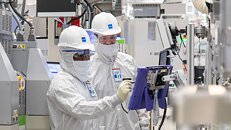- Joined
- Oct 9, 2007
- Messages
- 47,598 (7.45/day)
- Location
- Dublin, Ireland
| System Name | RBMK-1000 |
|---|---|
| Processor | AMD Ryzen 7 5700G |
| Motherboard | Gigabyte B550 AORUS Elite V2 |
| Cooling | DeepCool Gammax L240 V2 |
| Memory | 2x 16GB DDR4-3200 |
| Video Card(s) | Galax RTX 4070 Ti EX |
| Storage | Samsung 990 1TB |
| Display(s) | BenQ 1440p 60 Hz 27-inch |
| Case | Corsair Carbide 100R |
| Audio Device(s) | ASUS SupremeFX S1220A |
| Power Supply | Cooler Master MWE Gold 650W |
| Mouse | ASUS ROG Strix Impact |
| Keyboard | Gamdias Hermes E2 |
| Software | Windows 11 Pro |
Intel Foundry Services (IFS) today announced that it will commence mass-production on its first silicon fabrication node that leverages extreme ultraviolet (EUV) lithography, Intel 4. On September 29, the Intel 4 node will start rolling at the company's facility in Leixlip, Ireland, dubbed Fab 34. CEO Pat Gelsinger, Dr. Ann Kelleher, general manager of Technology Development at Intel, and Keyvan Esfarjani, chief global operations officer, will be present at a ceremony commemorating production of the first wafers.
Intel 4 is an advanced foundry that leverages EUV, and offers both transistor densities and electrical characteristics comparable to TSMC's 5 nm-class and 4 nm-class foundry nodes. Among the first chips to be built are the compute tiles of the company's Core "Meteor Lake" processors, which contain their next-generation CPU cores. Compared to the current Intel 7 node, Intel 4 offers double the area scaling for logic libraries, a 20% iso-power improvement, and introduces the new metal-insulator-metal (MIM) capacitor.

View at TechPowerUp Main Site
Intel 4 is an advanced foundry that leverages EUV, and offers both transistor densities and electrical characteristics comparable to TSMC's 5 nm-class and 4 nm-class foundry nodes. Among the first chips to be built are the compute tiles of the company's Core "Meteor Lake" processors, which contain their next-generation CPU cores. Compared to the current Intel 7 node, Intel 4 offers double the area scaling for logic libraries, a 20% iso-power improvement, and introduces the new metal-insulator-metal (MIM) capacitor.

View at TechPowerUp Main Site




